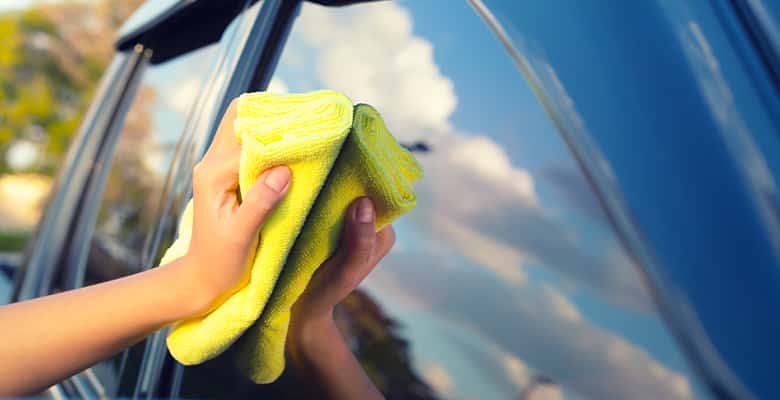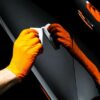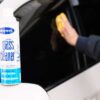Water-based Cleaners vs Solvent-based Cleaners

Did you ever hear the phrase, “They’re as different as oil and water?” It’s a relevant observation when it comes to water-based and solvent-based cleaners. Indeed, they are as different as oil and water. There’s quite a difference between a cleaner with water as the main ingredient and one that uses petroleum distillates.
Basics of Water-based and Solvent-based Cleaners
Solvent cleaners rely on the chemical dissolution of oils, greases and solids. Aqueous cleaners rely on soap/foam action and agitation. They dissolve both water-based and oil-based contaminants.
Water-based
Water-based cleaners use acidic or alkaline ingredients that you may be familiar with. Acidic compounds include citric acid and acetic acid. You’ll find them in lemon juice and vinegar, respectively. Alkaline (caustic) compounds include ammonia and bleach. A neutral pH is seven. Compounds with a pH of less than seven are acidic. Those with a pH higher than seven are alkaline. Water-based cleaners are popular for both interior and exterior car care.
Solvent-based
There are many solvent-based cleaners. Three common types are hydrocarbon, halogenated, and oxygenated. There are two categories of hydrocarbon solvents: aliphatic and aromatic. Kerosene and gasoline are examples of aliphatic solvents. Benzene, toluene, and xylene are examples of aromatic solvents. Halogenated solvents have a high solvent capacity and are non-flammable. Examples include perchloroethylene and 1,1,1-trichloroethane (methyl chloroform). Oxygenated solvents often have lower toxicity and high solvent power. Examples include various alcohols, glycol ethers, and ketones.
There’s certainly a place for carefully formulated, solvent-based car care products. For example, a tire treatment requires a solvent-based formulation to add moisture to dry tires. Polymer-based protectants are other examples. For example, ceramic wax protectant forms an effective barrier against solubilized contaminants encountered in puddles and on wet roads. They also resist the damaging effects of the sun’s UV rays.
Water-based vs Solvent-based Cleaners: Key Differences
Milder solvent cleaners include isopropyl alcohol, propylene glycol, and glycerin. Examples of stronger solvent cleaners are acetone, toluene, and trichloroethylene (TCE). The strongest formulations are used in heavy-duty industrial settings to tackle thick accumulations of grease, oil, and grime. Consumers use milder formulations to clean or treat rubber, metal, concrete and other compounds.
Water-based cleaners also exhibit robust cleaning characteristics. Effective formulations contain a careful blend of detergents, pH modifiers, chelating agents, and other compounds.
Here are some of the differences between water-based and solvent-based cleaners.
Surface tension
Compounds with high surface tension tend to “bead up.” Those with a lower surface tension have a greater ability to wet a surface. Solvent cleaners tend to exhibit less surface tension than aqueous cleaners. In certain industrial applications, that makes them effective at wetting into and evaporating out of tiny places. Chemists formulating water-based cleaners reduce surface tension with surfactants and emulsifiers.
Operating temperatures
Solvent cleaners are effective across a wider range of temperatures. Some solvent cleaners work from below freezing to more than 200 degrees C. Water-based cleaners are very effective at room temperatures, although some work at temperatures of up to 80 degrees C.
Flammability
Water-based cleaners are non-flammable. Some solvent cleaners are flammable, although others are formulated to minimize or eliminate flammability. With flammable cleaners, it is vital to avoid ignition sources and to adhere to all applicable safety protocols.
Evaporation rates
The evaporation rate of aqueous cleaners largely depends on the rate at which water evaporates. Slower evaporation rates require rinsing after application. Thorough rinsing removes solubilized contaminants like dirt, salt, grease, and oil.
Solvents often evaporate faster than water does. Companies may add chemicals to solvent-based cleaners to reduce evaporation rates. This gives a cleaner more time to dissolve solids and other contaminants.
With some solvent cleaners, there’s the challenge of volatile organic compounds (VOCs). They are volatile in that they readily evaporate at room temperature. That is, they easily change from a liquid to a gas. In a gaseous state, they can harm health and the environment. As a result, some manufacturers have moved toward low and no-VOC solvent cleaners. Those using solvent cleaners that contain VOCs need to work in well-ventilated areas.
Automotive Cleaning Solutions from Sprayway
Sprayway’s comprehensive line of automotive cleaners includes easy-to-use foam-action, non-drip formulas. The company promotes environmentally friendly products at every opportunity.
Automotive professionals have put their trust in Sprayway products since 1947. Sprayway’s interior and exterior car care products are American-made and world-class.
Recent Post

The Different Kinds of Tinted Windows...

The Different Kinds of Leather...

What Is The Difference Between...
